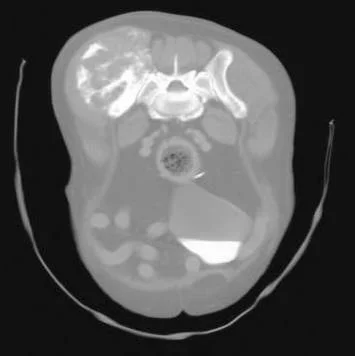PELVIC tumors
BACKGROUND
Pelvic tumors are uncommon in cats and dogs. The most common reason for presentation in dogs is a pelvic limb lameness, while other causes include a palpable mass or tenesmus and constipation; while a visible mass is the most common presenting sign in cats. The most common tumor types in dogs are soft tissue sarcomas, osteosarcomas, chondrosarcomas, hemangiosarcomas, and infiltrative lipomas; while the most common tumor types in cats are oft tissue sarcomas, osteosarcomas, and chondrosarcomas.
DIAGNOSIS
Survey radiographs may be sufficient for the diagnosis of pelvic tumors, but advanced imaging (CT or MRI scans) is preferred to determine tumor location, the extent of the tumor, and for surgical planning. Biopsy is rarely necessary as treatment options are not changed by a knowledge of the tumor type.
CLINICAL STAGING
Abdominal and thoracic CT scans are recommended to assess for metastasis to the sublumbar lymph nodes, intra-abdominal organs, and lungs. Alternatively, abdominal ultrasonography and three-view thoracic radiographs can be used to assess for the presence of metastatic disease.
TREATMENT
Surgery is the recommended treatment for cats and dogs with pelvic tumors provided that the tumor does not invade beyond the lateral third of the sacrum. There are a variety of surgical techniques described for management of pelvic tumors depending on the location and extent of the tumor. The majority of these involve concurrent limb amputation (for more information on functional outcomes following limb amputation, see Appendicular Bone Tumors for photos and videos), but limb preservation is possible for localized tumors of the ischium. Chemotherapy may be indicated following surgery depending on the tumor type.
PROGNOSIS
Dogs
The prognosis for dogs with pelvic tumors depends on the diagnosis. Local tumor recurrence was reported in 22.9% of 83 dogs treated with hemipelvectomy in one study, and the median time to local recurrence was 257 days. There was no association of local tumor recurrence with either completeness of excision or tumor type, but local recurrence was associated with a significantly increased risk of tumor-related death (3.8-times greater risk than dogs without local recurrence). Distant metastasis was reported in 44.6% of dogs with a median time to metastasis of 248 days. Four dogs with infiltrative lipomas were cured with hemipelvectomy. For six dogs with hemangiosarcoma, the metastatic rate was 83%, the mean survival time was 179 days, and the 1- and 2-year survival rates of 33% and 0%, respectively. For 34 dogs with soft tissue sarcomas, the local recurrence rate was 15%, the metastatic rate was 26%, the mean survival time was 373 days, and the 1- and 2-year survival rates were 47% and 38%, respectively. For 28 dogs with osteosarcoma, the local recurrence rate was 21%, the metastatic rate was 46%, the mean survival time was 533 days, and the 1- and 2-year survival rates were 51% and 35%, respectively. For nine dogs with chondrosarcoma, the local recurrence rate was 11%, the metastatic rate was 56%, the mean survival time was 1232 days, and the 1- and 2-year survival rates were 87% and 87%, respectively.
Cats
The prognosis for cats with pelvic tumors was significantly better than dogs with an overall 1-year survival rate of 75% in 16 cats. Local tumor recurrence was reported in 18.8% of cats, and the median time to local recurrence was 105 days. Distant metastasis was reported in 12.5% of cats, both with osteosarcoma, with a median time to metastasis of 197 days. The only prognostic factor in cats with pelvic tumors was complete excision of the tumor. For 11 cats with soft tissue sarcomas, the local recurrence rate was 9%, the metastatic rate was 0%, the mean survival time was 1789 days, and the 1- and 2-year survival rates were 75% and 75%, respectively. For three cats with osteosarcoma, the local recurrence rate was 0%, the metastatic rate was 67%, the mean survival time was 431 days, and the 1- and 2-year survival rates were 66% and 66%, respectively. For two cats with chondrosarcoma, the local recurrence rate was 50%, the metastatic rate was 0%, the mean survival time was 395 days, and the 1- and 2-year survival rates were 50% and 50%, respectively. Last updated on 6th March 2017
Last updated on 6th March 2017








